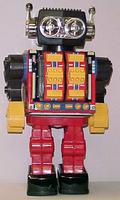| Monday, April 5, 2004 |
| Software and distorted thinking |
 Peter Coffee has a nice article in eWeek, "Spreadsheets: 25 Years in a Cell", about how our use of certain software tools shape our behavior, and how different tools set us up for different assumptions and different fallacies and different ways of wasting our time. Peter Coffee has a nice article in eWeek, "Spreadsheets: 25 Years in a Cell", about how our use of certain software tools shape our behavior, and how different tools set us up for different assumptions and different fallacies and different ways of wasting our time.
Some companies have forbidden Powerpoint presentations in meetings. Because often people use a considerable amount of time at making their presentation look really impressive with graphical effects, but the time is often not very productive. It takes them 10 times as long to say the same thing, and it might just make it less clear what they're actually saying. A simple set of bulletpoints is often more clear. And then there are spreadsheets: "There are two ways that spreadsheets, as we know them, distort our thinking and lead to bad decisions. The first distortion is the use of point values and simple arithmetic instead of probability distributions and statistical measures. So far as I know, there's no off-the-shelf spreadsheet product—certainly none in common use—that provides for input of numbers as uncertain quantities, even though almost all of our decisions rest on forecasts or on speculations.We assume that because we can put some numbers in a spreadsheet that they somehow become more real and certain. And since the spreadsheet programs typically have no good way of representing the actual uncertainty, we skip over the subject. And it isn't enough that our tool allows us to represent several different alternative scenarios: "The subjects whose tools invited them to imagine alternative scenarios believed they were doing a better job—even though statistical measures of their results showed no improvement in the actual quality of the forecasts. Those subjects did, however, take longer to perform the task. Isn't that the worst nightmare of those who must justify IT's return on investment—spending extra money on a more time-consuming product that yields absolutely no measurable improvement?"It is a bit of an embarrassing secret that many of our computerized tools simply allow us to waste more time on making it look like we know what we're talking about, covering up the fact that we really don't. We can get better tools, of course. Tools that better represent uncertainties and that show our assumptions more clearly. That's certainly an avenue to pursue. But we also need to develop our own built-in bullshit detectors, so that we can stay more conscious of the assumptions and fallacies inherent in what we're looking at, no matter how pretty and scientific it looks. [ Technology | 2004-04-05 08:00 | 1 comment | PermaLink ] More > |
| IM Bots |
 Via Liz Lawley news of Infocom Bots that let you play the great Zork text adventure games over AIM or iChat. It remembers how far you've gotten for next time you come back. That's great fun of course. And it instantly makes me think about all the things you could possibly do with IM bots. Like, I could have a receptionist that answered for me: Via Liz Lawley news of Infocom Bots that let you play the great Zork text adventure games over AIM or iChat. It remembers how far you've gotten for next time you come back. That's great fun of course. And it instantly makes me think about all the things you could possibly do with IM bots. Like, I could have a receptionist that answered for me:"You're in Flemming's entrance hall. Flemming is traveling in Transylvania right now. There's a blog here, and a mailbox, an SMS terminal, and a phone booth. There's a picture on the wall. There's a WIKI path going off to the right. There are three other visitors standing around looking bewildered. What do you want to do?"And you would go: "Look at picture!" or "Open mailbox!" or "Talk to visitors!". Of course, since it probably knows who you are based on the IM handle, it could be more personalized. You know, "Welcome back Jill, you haven't been here for a week", or "Your shared collaborative blog there, with three NEW postings", or, "There are two notes and a picture for you from Flemming". Really, I could also use an interface like that myself, if it were wired into my own mail and files and databases, etc. So, if I were on the road I'd just access my personal agent's IM, and it would tell me stuff like: "There are five phone messages for you, 52 new mail messages, 157 new postings in your aggregator. Your family went to the movies. It is 25 degrees. There are four computers there. On the wall you see a calendar and an address book."And I'd be able to tell it things like "Search for a file named 'Business Plan' on my computer!" or "Is there any mail from Joe?". And, really, if it can handle that, there wouldn't be such a big step to it doing it based on voice commands. So that I can have a conversation with my own agent. Nothing insurmountable in any of this. Tying various kinds of information together with some Apple scripting or something similar. For that matter, I could already use voice commands on my Mac if I bothered. What's the missing piece? That somebody just ties it all together for me into a killer application? [ Technology | 2004-04-05 16:40 | 0 comments | PermaLink ] |
| Square Wheels |
 From Roland Piquepaille's Technology Trends. So, you didn't think a bicycle could have square wheels? Well, it all depends on the surface you're riding on. From Roland Piquepaille's Technology Trends. So, you didn't think a bicycle could have square wheels? Well, it all depends on the surface you're riding on.Stan Wagon, a mathematician at Macalester College in St. Paul, Minn., has a bicycle with square wheels. It's a weird contraption, but he can ride it perfectly smoothly. His secret is the shape of the road over which the wheels roll.OK, so here's an idea: What about wheels that dynamically change shape quickly enough that they always fit whatever road surface you're going over, so that you can always have a smooth ride. And we might become less attached to smooth surfaces. [ Technology | 2004-04-05 16:57 | 7 comments | PermaLink ] More > |